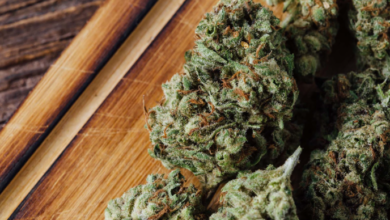The question of whether individuals can develop a tolerance to CBD is both intriguing and complex, as it touches upon the body’s adaptive mechanisms to cannabinoids. Unlike THC, which is known for its psychoactive properties, CBD interacts differently with the endocannabinoid system, raising questions about how consistent usage might alter its effectiveness. Factors such as dosage, frequency of consumption, and individual genetics all play a role in this phenomenon. Understanding these dynamics is crucial for users seeking to optimize their experience and therapeutic outcomes. What implications does this have for long-term use?
Understanding CBD and Tolerance
Cannabidiol (CBD) is a non-psychoactive compound derived from the cannabis plant, known for its potential therapeutic effects.
However, individuals may develop tolerance over time, necessitating an understanding of its mechanisms and implications.
CBD dosage and products vary widely, influenced by CBD extraction methods and legality.
Ongoing CBD research highlights both benefits and side effects, emphasizing the importance of informed consumption from reputable CBD sources.
See also: Best Cbd Gummies for Sleep
How CBD Interacts With the Body
CBD interacts with the body primarily through the endocannabinoid system, which plays a crucial role in maintaining homeostasis.
This interaction involves binding to specific receptors, influencing various physiological processes.
Understanding these receptor dynamics is essential for comprehending how tolerance to CBD develops over time.
Endocannabinoid System Function
The endocannabinoid system plays a crucial role in maintaining homeostasis within the body, and its interaction with cannabinoids like CBD can influence various physiological processes.
Through endocannabinoid modulation, CBD may help regulate mood, pain, and inflammation by interacting with receptors that maintain receptor homeostasis.
This modulation contributes to the overall balance of bodily functions, supporting a state of well-being and freedom.
Receptor Interaction Dynamics
Interactions between cannabinoids and the body’s endocannabinoid receptors are complex and pivotal for understanding the therapeutic potential of non-psychoactive compounds like CBD.
Receptor sensitivity affects how CBD modulates physiological processes, while the interaction duration can influence the overall effectiveness of the compound.
This dynamic interplay underscores the importance of studying CBD to optimize its use for various health applications.
Factors Influencing CBD Tolerance
Various factors play a significant role in determining an individual’s tolerance to CBD, including genetics, frequency of use, and dosage levels.
Individual variability, metabolic rates, and regularity patterns also influence tolerance.
Additionally, consumption methods and product quality, including cannabinoid profiles, affect how the body reacts to CBD.
Lifestyle factors further contribute to the need for dosage adjustments to maintain desired effects.
Differences Between CBD and THC
CBD (cannabidiol) and THC (tetrahydrocannabinol) are two prominent cannabinoids derived from the Cannabis plant, differing significantly in their chemical structures and effects on the body.
While THC is known for its psychoactive properties that can induce euphoria, CBD is non-intoxicating and is often associated with therapeutic benefits.
Understanding these differences is essential for individuals seeking to navigate their use of cannabis-derived products effectively.
Chemical Structure Variations
The chemical structures of cannabidiol (CBD) and tetrahydrocannabinol (THC) differ primarily in their arrangement of carbon, hydrogen, and oxygen atoms, which significantly influences their respective effects on the human body.
These molecular variations result in distinct interactions with cannabinoid receptors, leading to divergent therapeutic and psychoactive properties.
Understanding these chemical structures is crucial for informed decisions regarding cannabis consumption and its potential benefits.
Effects on the Body
Differences in the effects of cannabidiol (CBD) and tetrahydrocannabinol (THC) on the body stem from their unique interactions with the endocannabinoid system, which influences various physiological processes.
CBD dosage and long-term effects vary significantly among individuals due to metabolic factors and health conditions.
User experiences highlight individual variability, with some finding CBD beneficial without the psychoactive effects associated with THC.
Signs of Developing Tolerance
Developing tolerance to CBD can manifest through a gradual reduction in its effects, prompting users to increase their dosage to achieve the desired results.
Signs may include diminished relief from symptoms previously managed effectively.
In some cases, individuals may experience withdrawal symptoms when attempting to reduce or discontinue use, indicating the need for careful dosage adjustments to maintain balance and effectiveness.
Strategies to Manage Tolerance
Implementing strategies to manage tolerance is essential for maintaining the therapeutic benefits of CBD without increasing dosage unnecessarily.
Consider periodic tolerance reduction by taking breaks from CBD use, which can help reset receptors.
Additionally, dosage adjustment may be beneficial; lowering the amount temporarily can enhance sensitivity.
Regularly assessing individual responses ensures optimal use while promoting a balanced approach to CBD consumption.
Conclusion
In summary, the phenomenon of developing tolerance to CBD mirrors the gradual fading of a vibrant sunset, as the body acclimatizes to consistent exposure.
Factors such as genetics and frequency of use shape this adaptation, leading to diminished effects over time.
To preserve the therapeutic benefits of CBD, strategic management techniques, including dosage adjustments and periodic breaks, can serve as a lighthouse guiding users through the complexities of tolerance.
This ensures continued efficacy and satisfaction in their wellness journey.





